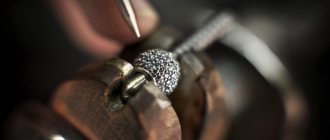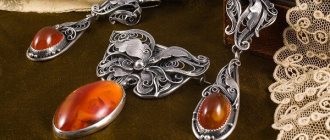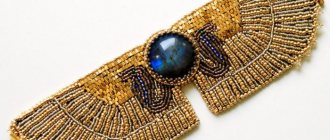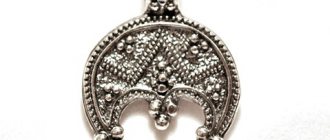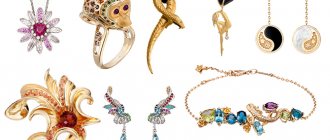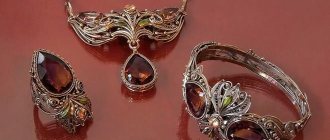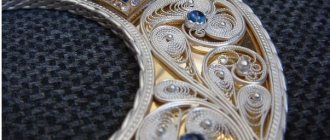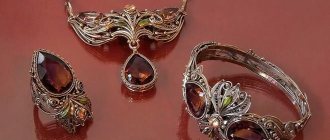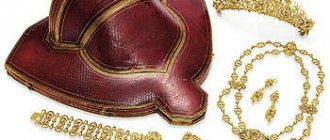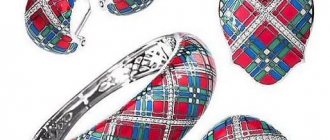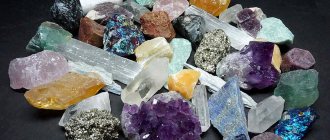Have you ever, while admiring jewelry, noticed that one of them costs much more than the rest, despite the fact that they are made from the same materials? But sometimes such differences are quite significant! But you shouldn’t think that a low price is an indicator of poor quality or careless work of the craftsman. The cost of the accessory varies depending on many features and nuances regarding the material from which it is made, the technique of work, the amount of effort expended and much more. And to help you choose a product that is both high-quality, attractive and inexpensive, a classification of jewelry was developed. Its principles, provisions and laws will be discussed in this article.
Filigree
You've heard the word "filigree" and always associated it with the meaning of "particularly careful" and "attentive to detail." You are absolutely right.
Filigree is a jewelry technique that is used by experts to create patterns from thin silver or gold wire. Filigree patterns can be in the form of herringbones, ropes, weaving and other patterns. This jewelry work is done under a microscope.
The term "filigree" has Latin roots. It comes from the words filum - “thread” and granum - “grain”. There is also a native Russian analogue - filigree jewelry technology. This word comes from the Old Russian “s’kati”, which means “to twist” or “to twist”.
Filigree is found both in jewelry and in boxes, vases and even on the hilts of ancient swords.
If you see a similar pattern on a piece of jewelry, you know that it is filigree.
Varieties of style
Jewelry filigree differs in the method of braiding precious wire onto the frame. In total there are 3 main types:
- The soldering technique involves applying wire and grains directly to a metal sheet (workpiece). If, at the end of the jeweler’s work, the master decides to leave the base, this technique is called background or “deaf”. And when the base is removed, the result is a cut or sawn filigree.
- The openwork method does not require the presence of a base. The wire pattern is soldered to itself, and the links and stones are attached directly to the metal lace. This type of filigree can be divided into two subtypes: flat and three-dimensional (sculptural-relief).
- Volumetric filigree - cubes, vases, trays, caskets and other works of jewelry, where individual elements are first twisted and then assembled into one composition.
Openwork filigree is considered a classic Russian style.
Diamond cut
This is a modern technique for processing precious metals. Its principle is that gold and silver are processed at a special angle by special cutters at different depths. After applying a diamond facet to the jewelry, the finest patterns are obtained that sparkle in any light, like real diamonds.
Enamel
The word has Greek roots and means “I mix.” In jewelry, enamel is the creation of designs on enamel. Jewelry enamel is not ordinary. It consists of transparent or opaque lead glass that covers the products.
Enamel is used on crosses, images of saints, icons and other similar objects. This is an excellent decoration that ensures longevity of jewelry.
It is thanks to enamel that icons are stored for so long that after hundreds of years they retain their original qualities and become antique.
Execution technique - how the jewelry is made
This sign is one of the most significant. It depends on him whether the pendant or ring you purchase will be exclusive and unique - or just another mass craft.
Today there are such varieties of execution techniques as machine, combined and manual. The machine provides for conveyor production of jewelry. A person participates in this process only at the most difficult stages, controlling quality and performing final operations. This is how unified jewelry is obtained - calibrated to the millimeter and standard. As a rule, they belong to the classic style.
The combined technology involves the manual assembly of individual parts of the accessory, obtained using machine techniques - stamping, pressing, casting. In addition, the master independently decorates the work with precious stones, overlays, adds a chain, clasp or lock, and performs final polishing and cleaning.
But, of course, it is best to buy handmade jewelry. As a rule, they are made in a single copy, which means you will be the owner of a rare and unique piece. These accessories are highly valued - after all, the craftsman spends a lot of time and effort on creating each of them, from project development to final finishing. And also unusual precious stones are often used in the work - for example, amber with inclusions or agate with an amazing pattern.
But, no matter what decoration you choose, you should like it and fit it. Only then will the accessory highlight your appearance and give you a lot of positive emotions!
Blackening
The word “blackening” itself already describes the process and result of the artistic technique. It consists in applying a special mixture (niello) to the relief of the jewelry.
The result is an effect that creates a contrast between the color of the precious alloy and the black mass inside it. Blackening gives the jewelry a special beauty and protects the jewelry from chemical influences.
The most popular metal for blackening is silver. Sometimes jewelers also blacken gold, but do not carry out such treatment with other precious metals.
Engraving
Engraving is the application of a design, ornament or inscription to a piece of jewelry. The engraving result is always in relief. One part of the pattern has a recess, and the other is convex.
Previously, every jeweler applied engraving using special cutters. This work was long and difficult. Microscopes have simplified the process somewhat, but not to perfection.
Nowadays all major jewelry companies do 3D engraving. Its essence is as follows. Designers give programmers the design they want to see in the image. The developers write a special program, thanks to which lasers apply the desired pattern in a matter of seconds.
You can talk endlessly about how hand engraving is done with passion, but you must agree: in any case, the program applies the edges with maximum precision. The end result is that you are wearing a perfectly engraved piece of jewelry.
Variety of jewelry - practical classification
One of the most common ways to systematize accessories is to group them according to practical criteria. This classification method is quite widely used in the CIS countries and Europe.
When distributing accessories, craftsmen are guided by the material used in them. Thus, real jewelry includes only those that were made from noble metals - platinum, gold, silver . Such a product is decorated with any materials - from diamonds to glass - and may even have no inserts at all.
The next group is jewelry haberdashery. These are works created from non-precious alloys (aluminum, bronze, nickel) - but with silver or gold plating. They may or may not contain various decorative inserts, but in any case they will be made of non-precious substances.
And finally, the last class is metal haberdashery. This includes most items from the category of inexpensive jewelry. Both the product itself and the insert decorating it will be made of non-precious, commonly found materials - beads, leather, iron, plastic, polymer clay. However, such works are often very original and unique.
This classification is a modified version of an older system that existed before 1998. It consisted of four different classes - real jewelry, jewelry haberdashery, art and stone carvings. But due to scientific and technological progress, which entailed the invention of new materials and operating technologies, the typification was modified. Nevertheless, some masters still use it.
Rhodium plating
Rhodium plating is the application of a thin layer of the precious metal rhodium to a product. This procedure is necessary to give the jewelry hardness and a particularly bright white color. You remember that gold and silver are soft metals, right?
Rhodium is a durable metal with amazing reflectivity. It keeps its shine much longer than gold and silver, so it costs several times more.
Never confuse noble rhodium with the radioactive chemical element radium. Rhodium is a safe and very expensive metal!
Precious or not - classification according to the material used
To understand what the cost of a certain accessory depends on, you need to be able to recognize the material from which it is made. It is on this basis that this typology was developed. Of course, a cast gold ring with a diamond or silver jewelry will cost much more than a craft made of nickel coated with a thin yellow plating!
So, precious metals include the following:
- gold . This ductile and soft noble metal is one of the oldest known to man. It has excellent heat and electrical conductivity and is easy to process. And the soft sparkle of the metal harmonizes perfectly with most precious stones;
- silver . It is harder than gold, but quite ductile and polishes well. Therefore, more detailed and practical works can be created from this metal;
- platinum . This metal is extremely rare. That is why it is classified as precious, although it is rarely used in jewelry - due to its hardness, platinum is difficult to process;
- palladium . Easily machined metal with a silver-gray color. It does not oxidize in air, which means that jewelry made from it will not darken over time;
- rhodium . This bluish-white metal is very hard and resistant to wear. In addition, it has extremely high reflectivity.
All other metals and alloys belong to the group of non-precious ones. But it is impossible to create such a clear classification of precious stones, because gems are evaluated based on a whole complex of signs and characteristics. Natural crystals may have inclusions or nuances of color (sometimes they cannot even be distinguished with the naked eye), which make an ordinary stone unique and exclusive - and therefore greatly increase its value.
Mokume Gane
Mokume Gane is an artistic technique that came to us from Japan in the 18th century. The technique involves giving the jewelry a woody structure. Professionals achieve this effect by layering precious metals and copper of different colors on top of each other. The result is a product that cannot be created from ordinary metal.
